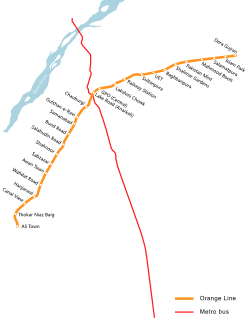History
The Lahore Metro was first proposed in 1991 and reviewed in 1993 by the Lahore Traffic & Transport Studies, funded by the World Bank. The project was subsequently shelved. In 2005, the Ministry of Transport revisited the project and carried out a feasibility study. In 2007, the Asian Development Bank provided Rs. 1 billion (US$3.5 million) to conduct a study on the project. The initial plan called for an 82-kilometre (51 mi) rail network with 60 stations to be constructed in four separate phases. The first phase involved the construction of a 27-kilometre (17 mi) rail line between Gajju Matta and Shahdara Bagh, with an 11.6-kilometre (7.2 mi) section underground. Construction was expected to start in 2008 and be completed by 2010. However, in 2008, the project was shelved again as priorities shifted to other projects.
In June 2010, Malaysia-based Scomi International proposed a US$1.15 billion monorail alternative, but that was not approved. At a ceremony in May 2014, an agreement was signed by Chief Minister Punjab Shahbaz Sharif, alongside President Mamnoon Hussain and Chinese Communist Party general secretary Xi Jinping, which gave the go-ahead for the construction of the Orange Line. The project was estimated to cost $1.6 billion.
Stations
The line has 26 stations. Anarkali and Central stations are underground, while the remaining 24 are elevated. [9] The rail line runs through the centre of each station, with platforms flanking the track. [10] Elevated stations have a width of 22.5 metres, while Anarkali Station is 16 metres wide, and Central Station 49.5 metres wide. [11] Elevated stations are all 102 metres long, while Anarkali and Central Stations are 121.5 and 161.6 metres long, respectively. [12]
Anarkali and Central Stations were initially planned to have two underground levels, [13] Anarkali Station now both feature a ground-level concourse with one underground level, while Central Station has a single underground level, in order reduce the maximum gradient for trains from 35% to 30%. [14] Rail tracks are 9.7 metres (31 ft 9.8 in) below street level at Central Station, and 8.7 metres (28 ft 6.5 in) below street level at Anarkali Station. [15]
Underground stations feature automated doors between platforms and trains. Public areas of the station are air-conditioned during warm months. [16] Elevated stations feature natural ventilation throughout the platforms, with localised air conditioning in public areas of the ticket-hall level. [17]
This page is based on this
Wikipedia article Text is available under the
CC BY-SA 4.0 license; additional terms may apply.
Images, videos and audio are available under their respective licenses.




